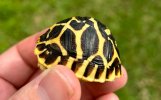tempest979
New Member
I've been looking through quite a few listings of Indian Star hatchlings for sale and I noticed, some are much smaller looking than others of same relative age, around 2 months. Some in fact look almost twice the size. I assume the listing is correct about species and age since it's from a breeder, why would that be the case? I know females are a lot larger than males but I assumed you would only notice after they become adults. Also I've noticed a lot of members here prefer breeding Burmese stars over Indian Stars. Is it because of the personality of Burmese Stars as Tom has said? I'm just curious as I know how to take care of them according to the guides I've read here by Tom and Mark, but don't know much about Indian Stars other than the fact that they are more shy and not as active.
